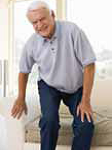 Prevention is key Sports massage should play an important role in the life of everyone, whether they are injured or not. Sports Massage Therapy is for everyone. For injury. For pampering. For deep relaxation.
Prevention is key Sports massage should play an important role in the life of everyone, whether they are injured or not. Sports Massage Therapy is for everyone. For injury. For pampering. For deep relaxation.
Lower back / buttock injuries
Sciatica is not a condition as such, but a symptom which can be caused by numerous conditions. The common sciatica symptoms involve pain that starts in the back and radiates down one (or both) of the legs.
It is quite a common complaint and sciatica pain is caused by pressure on the sciatic nerve which runs down into the leg. The medical term is acute nerve root compression or radiculopathy. The cause of pressure can be varied from a slipped disc (also known as a herniated or prolapsed disc), disc degeneration to muscle tension (Piriformis syndrome) or something less common such as a tumors, bony growths (stenosis) and infections.
The Piriformis muscle is one of the small muscles deep in the buttocks that rotates the leg outwards. It runs from the base of the spine (the sacrum) and attaches to the thigh bone (femur) roughly where the outside crease in your bum is.
Sacroiliac joint pain (SIJ) The Sacroiliac joints are located at the very bottom of the back. You have one either side of the spine. The Sacroiliac joints help make up the rear part of the pelvic girdle and sit between the sacrum (vertebrae S1-S5) and the Ilia (hip bones).
The concept of the SIJ causing lower back pain is now pretty well understood. However, due to the complex anatomy and movement patterns at the joints and area in general, evaluation and treatment of sacroiliac dysfunctions is still controversial.
Traumatic injuries to the SIJ are caused when there is a sudden impact which ‘jolts’ the joint. A common example is landing on the buttocks. This kind of injury usually causes damage to the ligaments which support the joint.
Biomechanical Pain due to biomechanical injuries will usually come on over a period of time and often with increased activity or a change in occupation/sport etc. The most common biomechanical problems include:
- Leg length discrepancy
- Overpronation
- ‘Twisted pelvis’
- Muscle imbalances
Myofascial pain or trigger points in the gluteus medious and piriformis muscles can cause pain in the buttock area. A trigger point is a tiny localized knot in the muscle. The muscles involved may also be shortened and tense.
